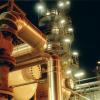Hi everybody!
I have folloving problem: cold water is sprayed into tank containing 80 deg C air. It cools the air down. If cooling is to fast, air intake connectino cannot supy air fast enogh and the vessel is squashed. In order, to size air intake connection to right dimension, I need to estimate, how fast will air be cooled.
Does anybody have any idea, how to estimate heat transfer rate?
Thanks
|
|
Cooling Rate
Started by Guest_majster_*, Jan 29 2008 08:45 AM
5 replies to this topic
Share this topic:
#1
 Guest_majster_*
Guest_majster_*
Posted 29 January 2008 - 08:45 AM
#2

Posted 30 January 2008 - 05:56 PM
This problem is one of simultaneous heat and mass transfer. Water droplets falling through the hot air are evaporating and effecting the heat transfer. There are many variables that would need to be defined in order to fully solve this problem. Just a few are the initial droplet sizes, the distance the droplets fall, and the rate of water circulation. The worst case is that the water and air immediately reach equilibrium. I would be very inclined to start with this, and to reduce water flowrate until you get an acceptable solution. If this is not acceptable at all, then you will have to jump into the (messy) simulataneous mass and energy transport equations. Have a big pad of paper handy.
Doug
Doug
#3
 Guest_majster_*
Guest_majster_*
Posted 01 February 2008 - 01:56 AM
Dear djack77494,
thank you for your answer. I susspected that such aproach will be needed. I did not poin out however, that I need estimate of cooling rate fast and I do not know if I have time for such complicated aproach.
Regards
thank you for your answer. I susspected that such aproach will be needed. I did not poin out however, that I need estimate of cooling rate fast and I do not know if I have time for such complicated aproach.
Regards
#4

Posted 04 February 2008 - 02:18 PM
If you don't want to do the calculations, then you can conservatively assume instantaneous heat transfer. As each droplet of water enters, assume it immediately mixes with the air and totally evaporates. The air and water vapor reach an equilibrium temperature. Think of that process continuing until the vapor mixture reaches saturation (which will probably happen fairly quickly). While this is not a very realistic approach, it is quick and it is conservative.
Doug
Doug
#5
 Guest_majster_*
Guest_majster_*
Posted 05 February 2008 - 04:42 AM
QUOTE (djack77494 @ Feb 4 2008, 09:18 PM) <{POST_SNAPBACK}>
If you don't want to do the calculations, then you can conservatively assume instantaneous heat transfer. As each droplet of water enters, assume it immediately mixes with the air and totally evaporates. The air and water vapor reach an equilibrium temperature. Think of that process continuing until the vapor mixture reaches saturation (which will probably happen fairly quickly). While this is not a very realistic approach, it is quick and it is conservative.
Doug
Doug
Dear Doug,
is it reasonable to assume, that water droplets will have wet bulb temperature on surface?
If this is so, there is difference betwen wet bulb temperature on surface and tempereture of core (which is lower).
If we assume droplet surface wet bulb temperature, can water tempereture rise above wet bulb tempereture?
Best regards
Majster
#6

Posted 08 February 2008 - 09:33 AM
[/quote]
is it reasonable to assume, that water droplets will have wet bulb temperature on surface?[/quote]
The very simple method I mentioned (but don't really endorse) is NOT all that reasonable. It is predicated on there being thermal equilibrium, which is NOT the case. It's advantages are that it's easy and quick; they come with a loss of accuracy which may be quite significant. The correct way was earlier described. You must make the decision on how much of a compromise you are willing to make.
Doug
is it reasonable to assume, that water droplets will have wet bulb temperature on surface?[/quote]
The very simple method I mentioned (but don't really endorse) is NOT all that reasonable. It is predicated on there being thermal equilibrium, which is NOT the case. It's advantages are that it's easy and quick; they come with a loss of accuracy which may be quite significant. The correct way was earlier described. You must make the decision on how much of a compromise you are willing to make.
Doug
Similar Topics
What Kind Of Cooling System Should I Use To Cool Down A Jacketed MixinStarted by Guest_HollyBoni_* , 31 Jan 2025 |
|

|
||
How To Estimate The Circulation Rate For Amdea (Mdea 45Wt + Pz 5Wt) BeStarted by Guest_tokotof_* , 29 Nov 2024 |
|

|
||
Psv Release Rate Vs TimeStarted by Guest_stu_* , 30 Nov 2024 |
|

|
||
Relieving Flow Rate In Terms Of Air EquivalentStarted by Guest_go-fish_* , 21 Nov 2024 |
|

|
||
Venturi Scrubber- Liquid Flow RateStarted by Guest_Chemeng40_* , 09 Nov 2024 |
|

|

 FB
FB







